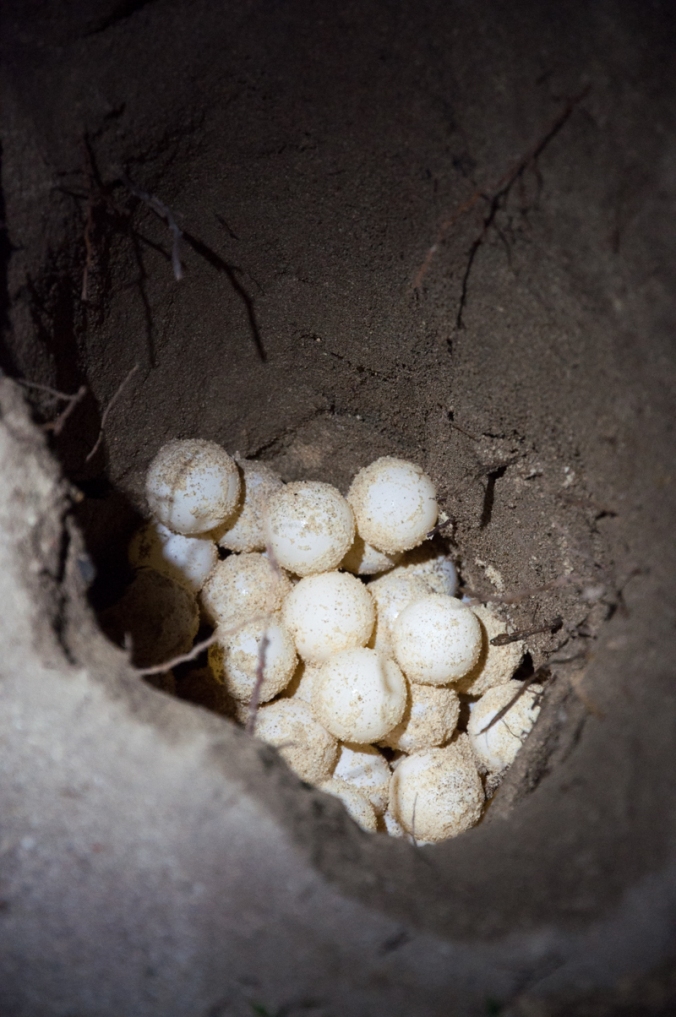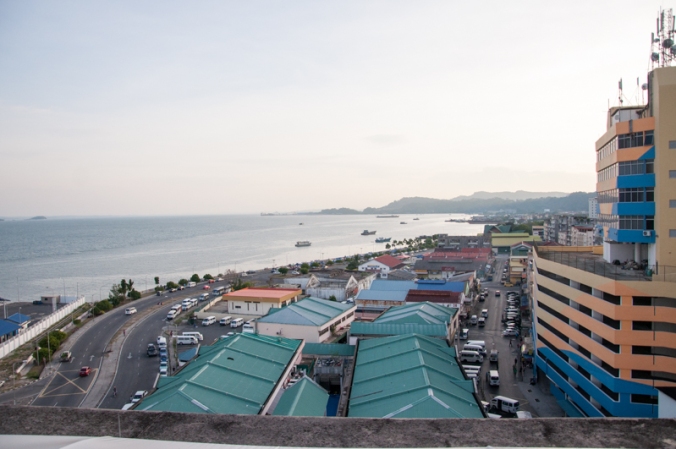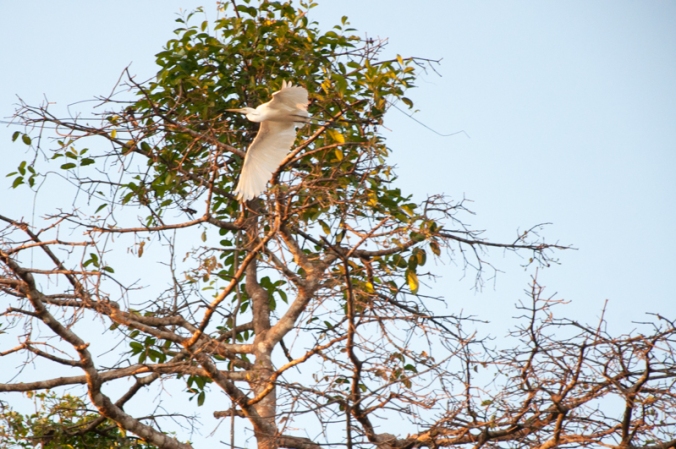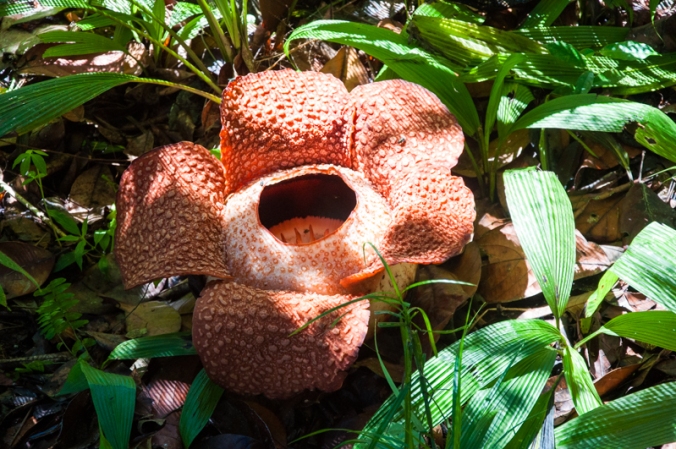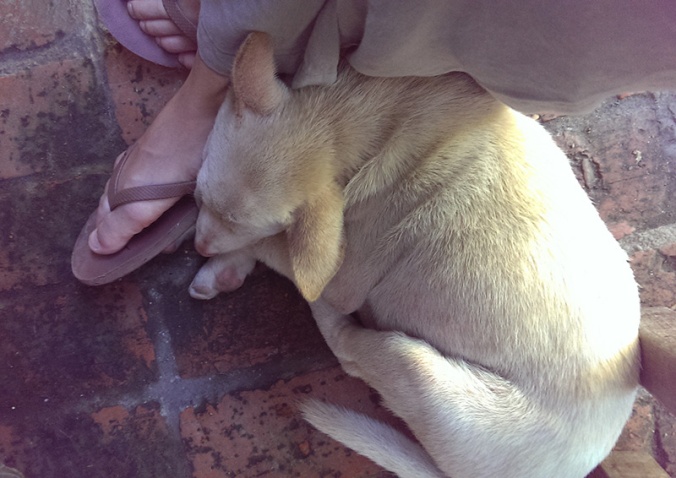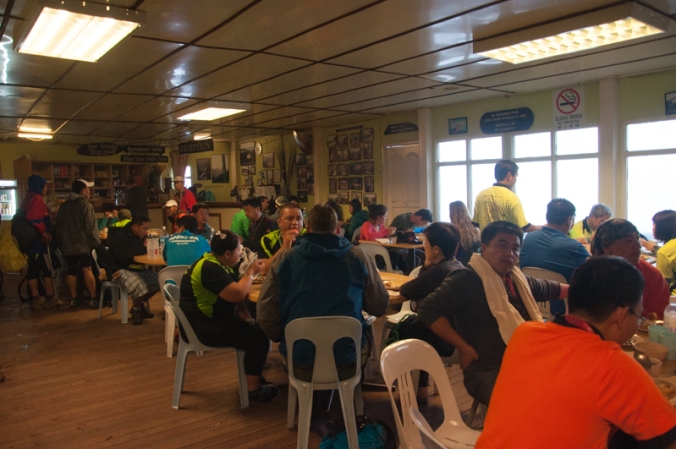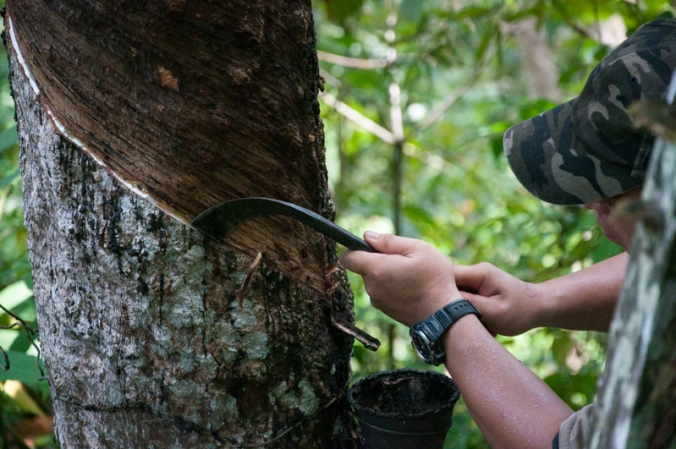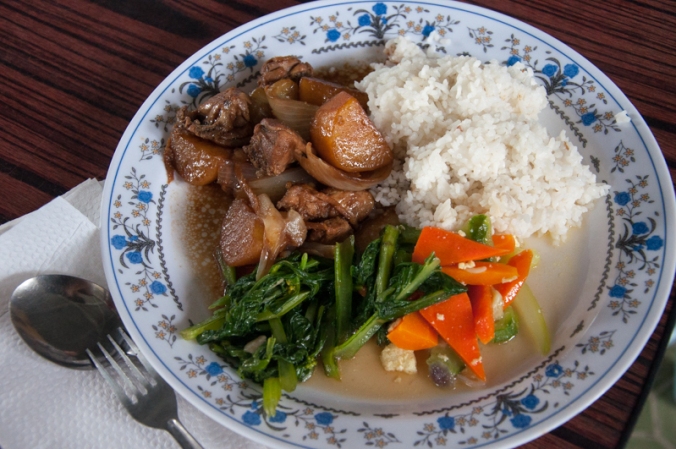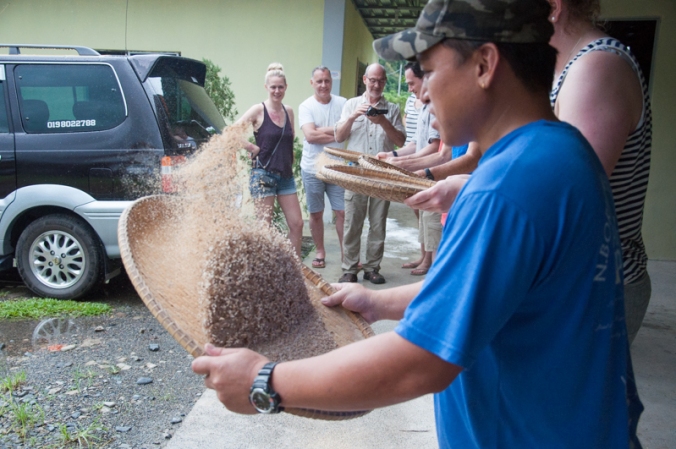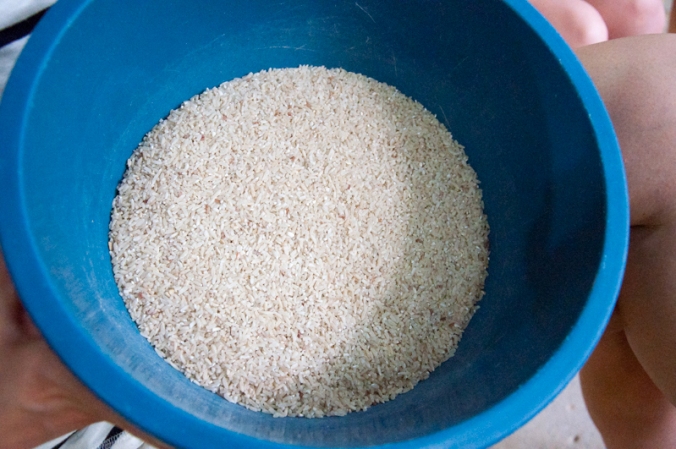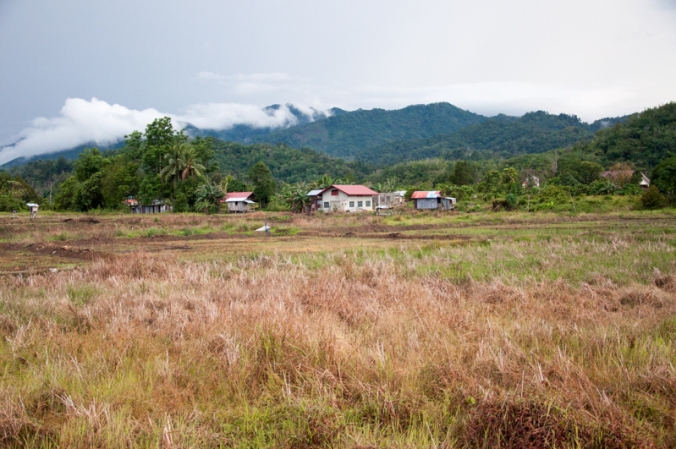I have a night of broken sleep. Not only is it noisy, but apparently sleeping at altitude is difficult anyway. I am awake when Aldrin’s alarm goes off at 2am and Laban Rata is already abuzz with excited climbers.
A coffee and a small bowl of cereal is all I can stomach at this early hour and we make our final preparations for the summit. We set off at 3am and it is cold and dark outside, but thankfully, not raining. There is a steady stream of people heading up to the summit despite the early hour. Everyone has the same idea as we do to see the sunrise at the summit of Low’s Peak.
The Low’s Peak summit is 2.8km away from Laban Rata and 8.7km from Timpohon Gate where we started yesterday. the climb starts off with a series of steep man-made steps, interspersed with rocky sections. The sections become more rock and less steps as we near the rock face. Because it is still dark out, we see by the light of headlamps. A trail of lights (and James) show us the way.
The Panar Laban rock face is traversed by hanging onto ropes cabled to the side of the cliff. We don’t realise it, but the other side from the rope is an almost straight sheer drop off the cliff. Darkness obscures this fact though so we don’t even know it until the climb back down. Shuffling along the mountain and pulling myself up the side of the mountain was SO much fun. There were frequent stops at people either tried to work out how to get up the mountain or froze in terror at the ridiculous predicament they had found themselves in.
As I snaked up the mountain, everything got even steeper and the low oxygen environment had me breathing hard and audibly. Just after the 7km mark is the check point where we have to show our passes. If you forget your pass, you will be asked to turn back.
The terrain becomes more even, but is still very steep. I find myself having to stop frequently after what only seems like a few shuffling steps to catch my breathe. The low oxygen environment means everyone is doing the same thing as me though.
I pass several people who appear to be succombing to altitude sickness and feel sorry for a girl I pass who is violently throwing up. Unfortunately, the only cure for her will be to go down to a lower altitude.
By this point, I can see the summit, but it is deceptive as it is still over a kilometre away. After what feels like an age, I finally spot the 8km sign post.

Mt Kinabalu by moonlight
It is slow going up the mountain, but I finally arrive at the base of the summit as the sky is beginning to lighten up. The climb up to the summit is tricky but I finally scramble along and pull myself up to reach the top. I find myself a rock and sit down with a huge sigh. It is 6am.

The view from Low’s Peak at the Summit of Mt Kinabalu
The view around me is spectacular. The sky is tinged with orange and the morning is clear and calm. Perfect conditions. It has been two days of pain, cursing, rain and exhaustion but the view is breath-taking and absolutely worth it.
Now that the sky has lightened up, I am able to finally take in the scenary around me. Rolling clouds, gorgeous hillside and jungle below is a stunning sight.
I grab a quick photo with the summit sign and watch the sunrise. There is not much room at the top with a few hundred people all vying for room.

I did it!
At 6:30am, I set off back down the mountain to head back to Laban Rata with Ronnie, Dave and Veronika. Going down was definitely hard on the knees and quite a few people freaked out about having to get down from the summit. That said, going down was a lot more fun than going up.

Veronika going down the mountain
In certain sections, I was able to basically abseil down the cliff (thank you thick gloves!) and those sections were by far my favourite part of the climb. Wheeeeeeeee!

Up to the summit
Now that it was light, it was also a good chance to finally stop and take in the surroundings we had climbed up in.
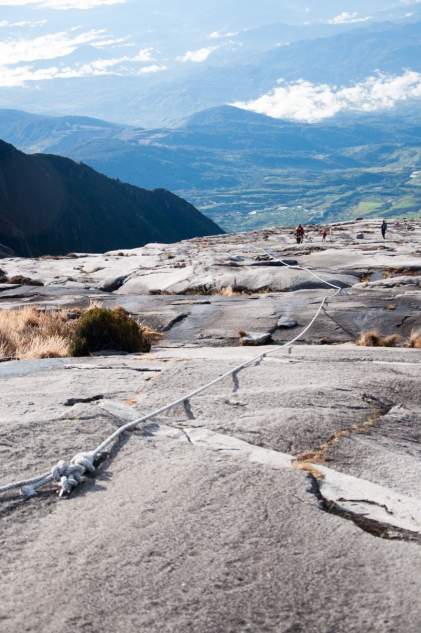

Mt Kinabalu
Sarah catches up with us in the last section and Team Alpha were re-united and once again crossed the line as the first group at 8:45am.
Exhausted, I tuck into a second breakfast and treat myself to another cup of hot Milo. We find out that a member of our group had succombed to altitude sickness with about 1km to go and had to turn back. Luckily, I seem to have dodged that bullet, feeling no ill effects other than those from the physical exertion and sore muscles.
The respite is short-lived as we’ve still got 6km of mountain to climb down. Team Alpha decided to leave at 9:30am to beat the inevitable afternoon rain. Soppingu is surprised we are leaving so soon, but points us in the right direction and tells us “look after each other…. no jumping!”.
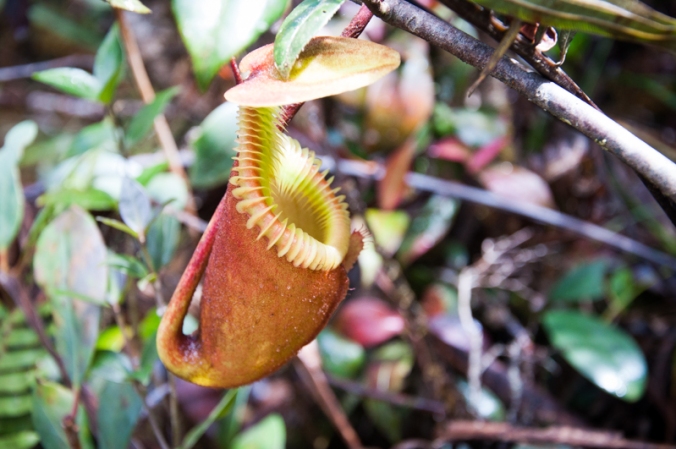
Pitcher plant
Although it isn’t raining, the rocks are still slick with water from the previous night’s rain and dew. Going down is tough as we try to find the balance between getting down off the mountain and not falling on one’s ass – which I admittedly did a couple of times. Suffice to say, it’s probably not the most graceful someone has looked coming down off the mountain.

Porter
There are far fewer people coming up the mountain than the previous day, but I do take time to stop and wish walkers heading up the hill good luck. I can be smug knowing that I have gone to the summit and know what pain they have in store tomorrow. SUCKERS!
The walk down wreaks havoc on the legs and knees. Reaching mile markers and huts become small victories as we slowly count down the distance remaining. When we finally (FINALLY!) see Carson Falls we let out a cheer, only to turn the corner and see the steps we have to go UP to reach the gate. We take a breather and tackle the last set of stairs. We all end up crawling to the top of the stairs and collapse. The time is 1:45pm and we have beaten the rain. Huzzah!
I ask a fellow finisher (I can tell he finished recently because he was drenched in sweat and looked knackered) to take a group photo of Team Alpha with the finishing sign. I offer to return the favour by taking his picture and he replies in broken English “this face now… not good for photos”. Gold.
Showing the guard our passes, we officially check out off the mountain.
Because we made such good time, our transport back to the park headquarters hasn’t even arrived yet. Tired and hungry we wrangle a taxi to take us to a restaurant across the road from the headquarters. We crave and subsequently destroy a plate of french fries each before walking (shuffling) back across the road to the park headquarters and waiting at the designated meeting point.
We find Barry and Ronny at the meeting point and catch up with them. As the afternoon rolls on, we can see the mist settling in and soon it is steadily raining. I feel bad for the walkers still coming down the mountain and am relieved our motley crew beat the rain.
It is 5pm by the time the last of our group stumbles in, soaked from the rain. We bid farewell to our guides before jumping on a bus and taking the 40 minute ride to our accommodation at Poring Hot Springs.
A quick shower and dinner are the first priority but everyone crashes soon after. Understandable as we have been up since 2am.
Borneo Travel Diary














